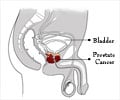A new prostate cancer screening method been developed by researchers.

"At a time when the value of PSA is being increasingly debated, we have shown that when used in a specific way, it can be of great value in identifying men with previously undetected prostate cancer," says the study's lead investigator, Dr. Steven A. Kaplan, the E. Darracott Vaughan Jr., Professor of Urology at Weill Cornell Medical College and director of the Iris Cantor Men's Health Center at NewYork-Presbyterian/Weill Cornell.
"We have shown that using PSA with these drugs can help us differentiate prostate cancer from benign prostate disease in patients who are difficult to diagnose," says Dr. Kaplan, who is also chief of the Institute for Bladder and Prostate Health at NewYork-Presbyterian/Weill Cornell. "It also demonstrates a better way to use both the PSA test and these powerful drugs."
Dr. Kaplan created the combination screening method as a way to understand cancer risk in men who have consistently abnormal PSA readings despite one or more negative biopsies. This patient population offers physicians a "diagnostic dilemma" he says -- "despite the fact that biopsies are becoming more and more effective at detecting cancer in the prostate, a significant number of patients with prostate cancer continue to have negative biopsies." He adds that the PSA (prostate specific antigen) test alone is not a good indicator of prostate cancer. "It measures multiple factors associated with prostate disease, including enlargement of the prostate and inflammation."
The research team decided to see what would happen to PSA levels after the use of two 5-alpha-reductase inhibitor drugs -- finasteride and dutasteride -- designed to reduce the size of an enlarged prostate. The theory is that these drugs might improve the usefulness of PSA in diagnosing prostate cancer. If the PSA remains persistently high even though the prostate has shrunk, or PSA rises after having reached its lowest level, it could indicate the presence of cancer. And when the gland is smaller, a biopsy can be more effective, according to researchers.
The study was conducted in two phases. It enrolled 276 men at NewYork-Presbyterian/Weill Cornell whose PSA was greater than 4, who had a normal digital rectal examination and two or more negative biopsies.
Advertisement
In the second phase of the study, 179 patients received the same drug therapy but underwent a biopsy only if their PSA showed a change of 0.4 ng/dl. In all, 42 men (27 percent) had the biopsy, and 26 of those participants (54 percent) had cancer. Within that group, 77 percent of the patients had high-grade tumors.
Advertisement
"Our study shows these drugs may be most helpful in helping us diagnose undetectable prostate cancer," Dr. Kaplan says.
Source-Eurekalert


![Prostate Specific Antigen [PSA] & Prostate Cancer Diagnosis Prostate Specific Antigen [PSA] & Prostate Cancer Diagnosis](https://images.medindia.net/patientinfo/120_100/prostate-specific-antigen.jpg)






